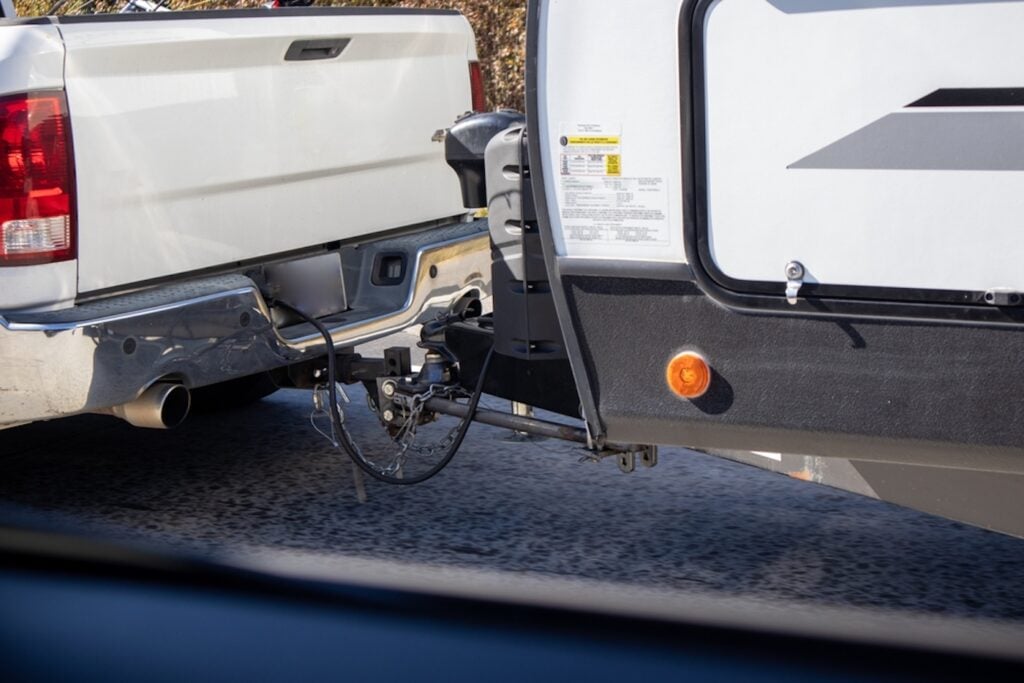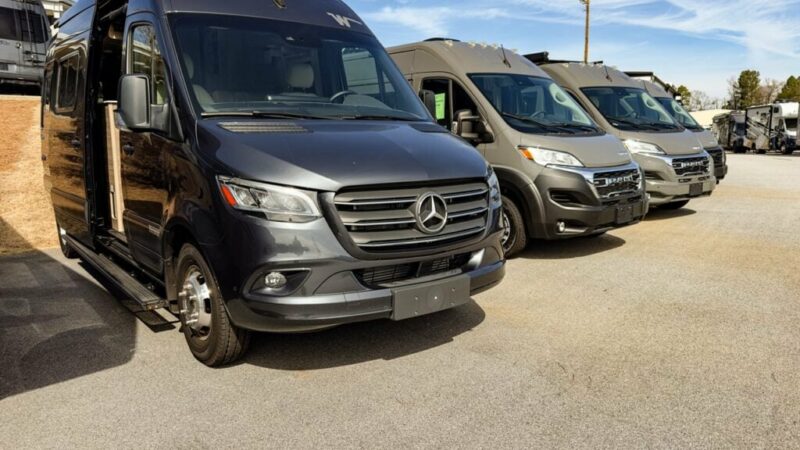RV Hitching Made Easy: Step-by-Step Guide for Travel Trailers and Fifth-Wheels
RV hitching is supposed to be a fairly routine and simple process, but it’s a little more complicated than that, especially for the first-time RVer. The priority is, of course, safety. Your future RV adventure comes second. You don’t want to be that RVer, helplessly watching your RV do its best impression of a horizontal flip down the side of a mountain.
Yeah, it’s funny in those terms, but not so much in reality. People can get hurt if your RV comes loose on the interstate or highway. For beginners, there are a few challenges, depending on the hitch and your familiarity with such things. But for safe towing, preventing damage, and reducing stress on the road, we hope to offer some clarity.
After all, there’s more than just one type of hitch, and we’re including both travel trailers and fifth-wheels as well. This is one of those things you want to get right the first time, and every time thereafter. There’s not much room for error on this topic. So, if you’re itching to learn a little bit about RV hitching and how best to protect yourself and your RV, here goes.
Why Proper Hitching Matters
The above situation may be difficult for some to watch. But if you fail to properly hitch your RV, that scenario becomes more possible. The hitch may not have been the problem, but RV sway is more likely if your hitch is misaligned, the hitch ball isn’t locked in, or your weight distribution is off.
Worse yet, sway is just one potential problem. You could damage the mechanism altogether, or the trailer might detach. Imagine the latter in a similar scenario to the above. You’re also looking at legal consequences, insurance claim denial, potential lawsuits in civil court … you probably get the point by now.
Most of the time, it boils down to the really simple stuff. For instance, how level is the ground the RV is parked on when hitched? That matters. Plus, hitch technology isn’t what it was 20 or even 10 years ago. There are receiver hitches (most common), fifth-wheel hitches, gooseneck hitches, weight distribution hitches, bumper hitches, sway-control hitches, and pintle hitches.
Each type of hitch works its magic and has its pros and cons. Then some components and accessories may make your RV-towing life a little easier on the highway, like spring bars, shanks, couplers, kingpins, locks, breakaway switches, AUX power, junction boxes, braking systems, camera systems, landing gear, chocks, and on and on it goes.
A lot of stuff, huh? What it comes down to is, competent RV hitching has a purpose and plays a large role in keeping you and others safe on the road.
Hitching Up a Travel Trailer: Step-by-Step
With all the proper warnings and precautions out of the way, it’s time to get into the details of RV hitching, starting with travel trailers. Travel trailers are more common, but if you own a fifth-wheel or are looking at one, feel free to scroll down to the next section.
Step One: Prepare the Tow Vehicle and Trailer
Sometimes, there just isn’t such a thing as an absolute. However, you want to make sure you are doing this on the most level strip of land you can find. You do not want to hitch your RV on an incline. Not everyone lives in perfectly flat areas, but do the best you can.
- Chock your travel trailer’s wheels
- Verify the tow vehicle’s hitch receiver and ball size (e.g., 2 inches or 2 5/16 inches)
- Ensure the trailer battery is charged (brakes, lights, and, you know, important stuff)
- Prepare to align your tow vehicle, preferably with some guidance from a friend or family member.
Step Two: Align Your Tow Vehicle
Back the tow vehicle into position, with the hitch ball directly under the trailer’s coupler. Experienced RVers can do this in their sleep, even without someone behind them guiding the tow vehicle in. However, if you’re new to this, having someone back there (spotter), and/or a reverse camera, is beneficial.
“We got ours at Harbor Freight, about $10 for the pair. Since our tonneau cover blocks the view of the fifth wheel hitch, they have made hitching up a breeze. Have also seen them at Walmart, for about twice the price.”
Just remember that they’re back there and let them know to be aware of their surroundings and always make sure they have a quick “get the heck out of the way” outlet in case something goes wrong. For what it’s worth, there are a bunch of different alignment tools for DIY RV hitching, if you prefer.
Step Three: Adjust Trailer Height
Now it’s time to hop out of the cab or get your spotter to do some actual work. The trailer height may need a slight adjustment up or down until it is 1-to-2 inches above the hitch ball. Use the A-frame (tongue) jack to make it so. Check for level alignment with the tow vehicle.
Step Four: Connect the Coupler
Lower the coupler onto the hitch ball until it locks into place (listen for a click if it’s quiet enough outside). Now, grab the coupler latch and lock it down, securing it with a safety pin or lock, depending on the type.
Step Five: Attach Safety Chains and Breakaway Cable
Grab your safety chains and cross them beneath the tongue, attaching each to the tow vehicle loops. Clip the breakaway cable to a fixed point other than the hitch ball. The chains are a secondary safety measure for keeping the trailer somewhat attached in case the ball hitch fails. The breakaway cable is designed to activate the trailer’s brakes if it “breaks away.”
Step Six: Connect Wiring Harness and Test
Plug in your trailer’s wiring harness, and you’re now looking at three different connection points from trailer to towing vehicle: chains, hitch/receiver, and wiring harness. If you have a brake controller in the tow vehicle, make sure it is properly installed and functional, in terms of working with your RV’s system.
Don’t skip the testing part, even if you assume everything is in good working order. Have your spotter stand back and communicate a thumbs up or thumbs down as you work your way through testing the brake lights, turn signals, running lights, and hazards. When all of the above checks out, you can move on to the next step.
Step Seven: Final Checks
When you’re all set, raise the tongue jack, remove the wheel chocks, and retract the stabilizers. It may sound a bit redundant, especially if you have a spotter out there, but go ahead and do another walk-around, checking to make sure everything is in good working order.
Hitching Up a Fifth-Wheel
RV hitching isn’t exclusive to travel trailers. In fact, when it comes to towing, fifth-wheels have a lot of advantages, especially where stability is concerned. However, it’s an entirely different animal, using a bed-mounted hitch system rather than a traditional hitch and ball. As with travel trailers, some things remain the same, such as level ground and using a spotter if necessary.
Step One: Prepare the Tow Vehicle and Trailer
You know the drill. Make sure you’re on level ground, chock the trailer wheels, and lower the landing gear. Make sure the fifth-wheel hitch (saddle) is unlocked and the kingpin plate is greased. Also, make sure you know the trailer’s kingpin height (typically 47–50 inches) and adjust the landing gear to position the kingpin 1–2 inches below the hitch jaws.
Step Two: Align the Tow Vehicle
Using a spotter or a backup camera, back the truck/tow vehicle until the hitch jaws are directly beneath the kingpin. The only thing you have to worry about, assuming you’re new to this, is getting everything aligned and working with your spotter (or, of course, getting used to lining things up with just a reverse camera to look at).
Step Three: Connect the Kingpin to the Hitch
Very slowly, ease the truck in reverse until the kingpin locks into the hitch jaws. You may hear the click, but you’ll also get a feel for it over time. Confirm the hitch is locked via the latch or indicator pin. Try not to run over your spotter. They won’t appreciate it.
“Very, very good point about locking it so the jaws cannot be opened! Really appreciate the insight! I don’t need a lawsuit! since my hitch mounts into the factory installed pucks in the bed. It should be a very simple task to [get] unattached from them.”
Step Four: Attach Wiring Harness and Breakaway Cable
Like travel-trailer-hitch arrangements, fifth-wheels also have a wiring harness and breakaway cable for safety and for providing communication between the tow vehicle and fifth-wheel. Attach the breakaway cable to a fixed point in the truck bed and make sure your wiring harness is clean and connected. Test everything to make sure it’s in good working order.
Test your brake lights, turn signals, hazards, and running lights. Walk around and give everything a gentle tug to make sure it’s properly connected and secure.
Step Five: Raise Landing Gear and Final Checks
Use your landing gear to slightly lift the trailer, relieving the hitch pressure, and check everything over. Fully retract the landing gear and make sure you secure the crank handle. Remove the wheel chock, ensure tailgate clearance, and secure the gear in your truck bed. One last walk around wouldn’t hurt either.
Pintle Hitch
Now, it’s time to get down to the nitty gritty on some less common hitching systems out there. Bed-mounted and traditional hitches are two of the most common, but they’re not the only ones. The pintle hitch is another variation. It’s a heavy-duty, hook-and-loop system that you don’t see often in RVs (mostly in industrial, agricultural, or military applications), but never let it be said that I left an RVer hanging.
Pintle hitches typically show up in custom or specialized RVs. There are no major RV manufacturers that produce RVs designed for towing with a pintle hitch setup. However, with the number of custom RVs growing in circulation (and military RVs transitioning to civilian recreation), you never know. Besides, it’s an interesting side note.
As with the previous two variations, level ground is the most important starting factor. Be sure to inspect the pintle hook on the tow vehicle and lunette ring on the trailer for wear, damage, or any debris.
- Align your vehicle by backing it up until the pintle hook is directly under or slightly behind the lunette ring.
- Adjust the landing gear or tongue jack until the lunette ring is 1–2 inches above the pintle hook.
- Open the latch on the pintle hook and lower the lunette ring until it slides over the hook.
- Connect the safety chains (Crossed “X” pattern), attach the breakaway cable, and plug in the wiring harness.
- Remove the wheel chocks and raise the tongue jack/landing gear.
- Check for excessive noise or movement, as pintle hitches are often noisier than their cousins.
The hitching process is a lot simpler with a pintle hook, and it allows for a greater range of movement when you’re off-roading. If you’re heading off the beaten path a lot, this might be an ideal system to consider. It’s not as effective with really tall RVs, however, so that’s something you may have to consider in your RV hitching calculations.
Gooseneck Hitch
The gooseneck hitch is a variation of the bed-mounted hitches used for towing a fifth-wheel. Instead of a kingpin, they use a ball and coupler, which is the greatest distinction between the two. Gooseneck hitches can tow up to 30,000 pounds and are used for specialized RVs, livestock trailers, and flatbeds. You know the drill. Make sure you’re on level ground before beginning.
- Make sure the wheels are chocked and the gooseneck ball (mounted in the truck bed, typically directly above or slightly forward of the rear axle) is clean and lubricated.
- Lower the truck tailgate to provide extra clearance for the gooseneck arm and avoid damage.
- Back the tow vehicle up until the gooseneck ball is directly beneath the trailer’s coupler.
- Adjust the coupler’s height so it’s 1–2 inches above the gooseneck ball.
- Lower the coupler onto the gooseneck ball using the landing gear/jack until it locks in place (some designs feature a manual lock).
- Attach the safety chains (if applicable), ensuring enough slack for turns.
- Connect your wiring harness and breakaway cable to a fixed point in the truck bed.
- If clearance allows, close the tailgate.
- Raise the landing gear/jack so you’re fully in towing position.
- Remove the wheel chocks, do a walk around, and a little test drive to ensure everything is turning smoothly.
RV hitching with a gooseneck setup allows for tighter turns than a traditional fifth-wheel hitch. However, like the pintle hook, it’s not as good with tall RVs, though it does take up less space in the bed.
Hensley Arrow or ProPride Hitch
Hensley Arrow and ProPride 3P hitches are premium, patented hitches that lean heavily into weight distribution and sway control. Travel trailers only. The connection point is different than traditional RV hitching systems because it uses a pivot point projection design that transfers the trailer’s pivot point to the tow vehicle’s rear axle. The system is permanently mounted to the travel trailer’s frame.
“I have had mine about 2 or 3 years now. i like mine real well. A year and half back I pulled my camper from Ohio to Tennessee. I aired my tires up to the max pressure on the side wall of my tow vehicle and it pulled great. I have no regrets about buying a Hensley.”
The hitching process is very simple, but you may still need a spotter or backup camera to align everything. When you back the tow vehicle up, you align the “stinger” on the tow vehicle with the large, square receiver. Then, secure it with a hitch pin and clip.
Everything else remains the same, connecting your wiring harness and your breakaway cable in the same manner.
Troubleshooting Common Hitching Issues
Once you get used to hitching up your RV, the process is relatively simple, regardless of the RV hitching method you use. However, there’s always room for error, and anything can go wrong on any given day. If you’re having issues with the process, here are some fairly common troubleshooting tips.
Issue 1: Misalignment (Travel Trailer/Fifth-Wheel):
Lining up the hitch and receiver is an “experience” sort of thing. You get better at doing it the more you do it. If it’s problematic at first, try using cones or markers. If you have someone there, use them as a spotter to keep you aligned as you back the tow vehicle up.
Take it slow. There’s no reason to practice your Formula 1 skills while hitching an RV. You can purchase alignment cones that are designed for RV hitching, providing you with a visible marker that sticks up above the hitch. Use it enough times, and you won’t even realize you don’t need it anymore, long before you take it down.
Issue 2: Coupler/Hitch Won’t Lock:
This is surprisingly common, and it’s usually nothing more than debris. Clean it out and make sure the coupler/hitch is clear. Maintain lubrication on friction points and sway bars, the hitch ball (yes, there’s heated discussion on this within the RV community), spring bar sockets, adjustment bolts/screws, kingpin, jaws, and pivot points.
Rust and corrosion will eventually be an issue if you don’t keep up on the preventive maintenance side. Lubricate prior to towing season, but make sure the components are clean prior to. Also, maintain lubrication every 1,000–2,000 miles.
Issue 3: Electrical Connection Failure:
Inspect your 7-pin connector for corrosion. It’s fairly common, so it’s the first thing you should look for. Exposure to rain, road salt, or humid environments takes a toll. Also, look for bent pins, a cracked housing, or broken locking tabs.
Check for frayed or exposed wires and make sure everything is secured with zip ties so the connector isn’t dragging along on the ground. Use a multimeter if everything checks out visually. The ground pin (usually the center pin) may have a weak or broken connection as well.
Issue 4: Excessive Sway (Travel Trailer):
For fifth-wheel kingpins, height adjustments are usually the problem, especially if this is your first rodeo. Verify your distribution setup and make sure your hitch weight is 10%–15% of the trailer weight. How you load your RV can and will have an effect on its handling, so make sure you equally distribute the weight.
It’s a good idea to keep an RV hitching checklist handy until you can do this in your sleep.
Safety Tips and Best Practices
RV hitching safety is practice and repetition, though the repetitive and familiar process can turn into you missing something along the way. The best course of action is to stick with a process where your safety checks are all included. Once you get used to the repetition, you’ll naturally look out for these issues in the future.
- Always chock your wheels and use level ground to prevent trailer movement.
- Double-check hitch locks, safety chains, and electrical connections before driving.
- Verify your tow vehicle’s hitch ratings (GVWR, hitch capacity) are a match for the trailer weight.
- Practice makes perfect. If you’re not used to RV hitching, practice the process in an empty lot until you are comfortable with the procedure.
- Invest in quality equipment, such as weight distribution hitches or heavy-duty fifth wheel hitches.
- Use a spotter, wireless backup cameras, or alignment cones.
- Maintain your hitch and components by greasing your plates, cleaning your couplers, and inspecting everything for wear and tear periodically.
Yeah, it’s easy to get used to the ebb and flow of RVing—the process of setup and breakdown, traveling, and whatever adventures you have in front of you. It gets easier and easier to overlook, ignore, or put off preventative maintenance. It happens. We’re only human after all…hopefully. But take the time to maintain your stuff, especially your hitch and all the related components.
It may mean the difference between safely arriving at your destination on your next trip, or pacing on the side of the road, wondering how or if your insurance is going to cover this.
Conclusion
RV hitching really isn’t that bad, regardless of your particular setup. It takes a little getting used to for newbies, especially the whole backing up and aligning thing. Practice and repetition will get you there before you know it. Preventive maintenance will keep you there while making your life, and the lives of everyone around you, safer.
You don’t want to be the RVer in that first video. It won’t work out well for anyone. If you’re having trouble or this is your first time hitching up, do your due diligence and be sure to take your time.
The post RV Hitching Made Easy: Step-by-Step Guide for Travel Trailers and Fifth-Wheels appeared first on RV LIFE.
Source: https://rvlife.com/rv-hitching-made-easy-step-by-step-guide-for-travel-trailers-and-fifth-wheels/






